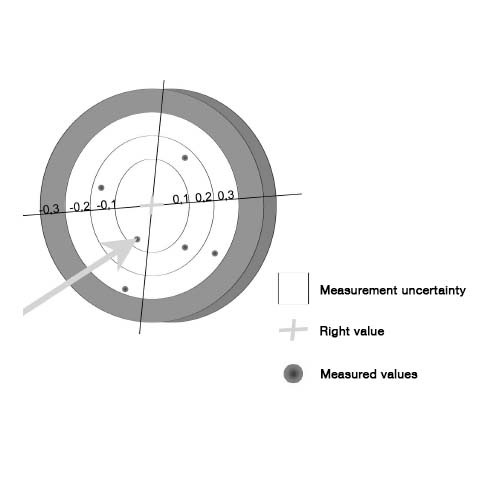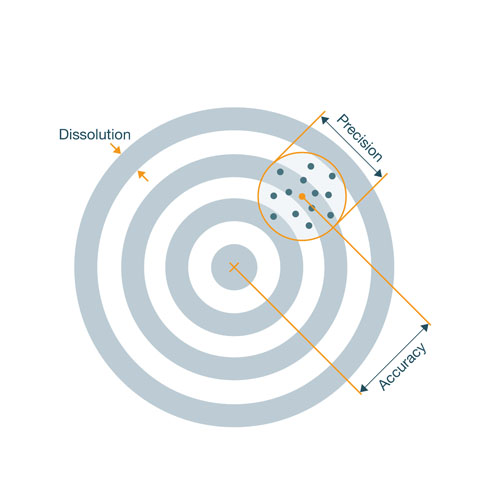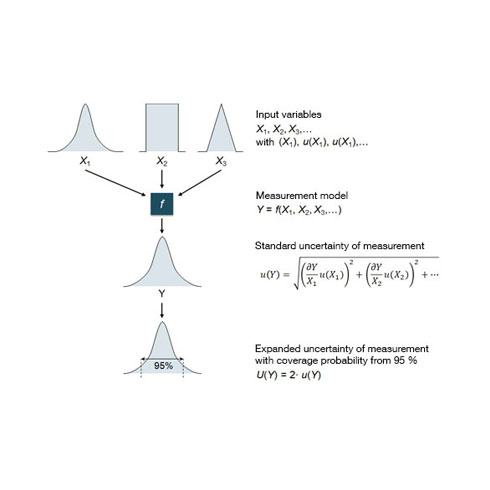Fundamentals of measurement uncertainty
This knowledge page answers questions on the meaning, relevance, impact, determination and calculation of measurement uncertainty. In this context, you will receive information on the sensitivity coefficient and the measurement uncertainty balance/budget.
Here you will find answers to the following questions:
- What does uncertainty of measurement mean?
- Relationship between: Precision, accuracy and resolution
- Why is the measurement uncertainty relevant?
- What is the effect of measurement uncertainty in the context of calibration?
- How is the measurement uncertainty determined and calculated?
- What does uncertainty of measurement according to GUM mean?
- Statistical principles for the calculation of measurement uncertainty
- What does sensitivity coefficient mean in the context of measurement uncertainty?
- What is a measurement uncertainty balance/measurement uncertainty budget?

What does uncertainty of measurement mean?
Measurements do not provide absolutely accurate values, as they are always subject to imperfections and imperfections which cannot be precisely quantified. Thus, the result of a measurand depends on the applied measuring method, the environmental conditions such as temperature, humidity and ambient pressure, the performance of the measuring technique used (offset, drift) and the competence of the calibration technician.

Relationship between: Precision, accuracy and resolution
The resolution is understood to be the smallest counting unit, in this case the distance between the rings of the target. The dispersion of the bullet holes indicates the precision, it is a measure of the reproducibility of the hits. The dispersion of the bullet holes to the center of the target is expressed by the accuracy. (Only systematic deviations are taken into account)
Why is the measurement uncertainty relevant?
In order to evaluate and further use the result of a measurement, a statement on the quality of the result must be made in addition to the determined estimated value of the measurand. The indication of the measurement uncertainty strengthens the confidence in the measurement results and enables the comparison of different measurements. This is a basic requirement in the national and international exchange of goods. There are also other reasons to deal with measurement uncertainty; for example, if the measurement is part of a calibration and must be shown on the calibration certificate, or if compliance with the accuracy specification of a measuring instrument must be evaluated. "A measured value without measurement uncertainty is not a complete measurement result!"
What is the effect of measurement uncertainty in the context of calibration?
During calibration, it is checked whether the sensor complies with the specified accuracy. The deviation found shall be less than the permitted deviation. However, calibration itself, like any measurement, is subject to uncertainty. This is given in the form of the measurement uncertainty. The measurement uncertainty is mainly composed of error influences of the operator, the test item, the method and the reference. The measurement uncertainty is a measure for the random scatter of the measurement result and is therefore indicated with +/-. It must be included in the conformity assessment, depending on the decision rule.
How is the measurement uncertainty determined and calculated?

The determination of the measurement uncertainty is usually carried out according to the described procedure. The individual influence quantities Xi, are described according to their distribution as probability functions u(Xi), offset with the associated sensitivities from the measurement model Y = f(Xi) and combined via the method of quadratic addition to a standard measurement uncertainty u(Y). The standard measurement uncertainty u(Y) is the measure for the scatter of the measurement. In order to express a range of values in which the true measured value lies with a probability of usually 95%, the level measurement uncertainty is multiplied by a coverage factor. In most cases a normal distribution is applicable. The multiplier corresponds to the numerical value 2.
What does uncertainty of measurement according to GUM mean?
The "Guide to the Expression of Uncertainty in Measurement", abbreviated as GUM, is regarded as the globally accepted standard for the evaluation and specification of measurement uncertainties and has been adopted by several international organisations. The GUM follows the approach of stating each measurement result as the best estimate of a measurand with the associated measurement uncertainty. Thus, the GUM method provides a clearly defined evaluation procedure to perform the description of the measurement task and the variability ranges of relevant quantities using probability distributions and model equations. This means, with the help of the GUM method it can be shown transparently which correlations are used for the determination of the measurement uncertainty and how the estimation of involved quantities are regarded.
Statistical principles for the calculation of measurement uncertainty
In general, metrological experience shows that measurement processes cannot be controlled so precisely and measurement conditions cannot be specified so accurately that only one single value can be assigned to a measurand. Therefore, the solution lies in describing the incomplete knowledge by distributions of values whose weight is estimated. More or less exact knowledge about tolerable values of a measurable quantity is described by distributions of the possible values. The probability density determines the weight given to a value Y of size X based on the available knowledge. In order to be able to carry out a corresponding measurement uncertainty calculation later, the basics of probability calculation or statistics are necessary:
Distribution functions, such as:
- Rectangular, trapezoidal, triangular, bell-shaped (Gaussian bell curve) distribution.
Other statistical parameters, such as
- Arithmetic mean, range, standard deviation, error propagation
What does sensitivity coefficient mean in the context of measurement uncertainty?
The sensitivity coefficient describes the extent to which the estimated value of the result variable is influenced by changes in the estimated value of the input variable. It can be determined from the model function using equation or numerical methods.
What is a measurement uncertainty balance/measurement uncertainty budget?
The uncertainty analysis of a measurement - often called the measurement uncertainty budget - should include a list of all sources of uncertainty during the measurement, together with the associated standard measurement uncertainties and an indication of how they were determined. In the case of multiple repeated observations, the number n of observations made should also be reported.